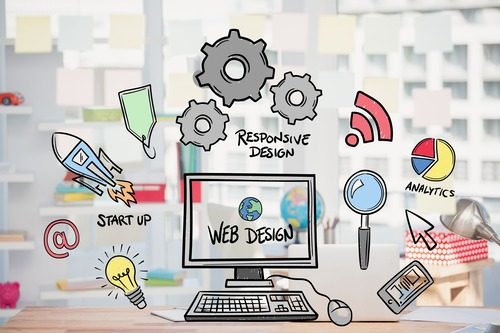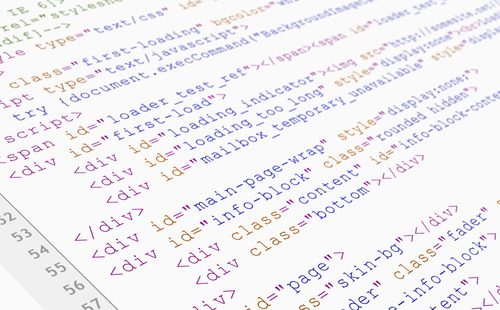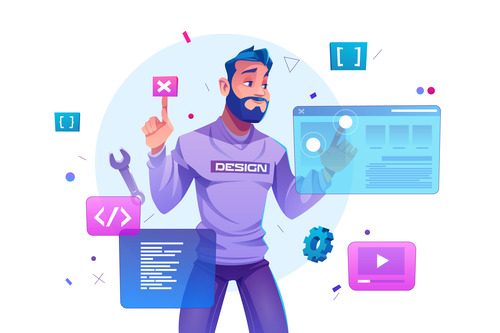In the era of dial-up internet connections, merely having a website was enough to distinguish a company from its peers. Over the past two decades that landscape has changed dramatically – from personal blogs to sprawling corporate websites, there are currently just shy of two billion websites worldwide.
Websites have become a tremendous resource for businesses of any size, allowing them to reach and engage customers around the world 24 hours a day, 7 days a week. Unlike most other forms of marketing, the cost of website hosting and design allows smaller businesses a more balanced footing when competing against larger rivals. Millions of potential customers are never more than a Google search away, but the competition is immense – the biggest challenge is standing out amongst the crowd.
It is easy to say well-designed websites are the key to success, but what exactly makes a website successful? While the answer to that can be subjective, several elements of web design will greatly enhance its overall appeal.

Stunning Visual Design
Busy lives and media bombardment have eroded the average person’s attention span to roughly EIGHT SECONDS. That is not a lot of time to make an impactful first impression. The most effective means a designer has to hook their audience quickly is through visual design.
Since most people are visually oriented, having an appealing aesthetic is a great way to attract and retain a visitor’s attention. The layout should be cohesive across the site with complimentary colour schemes, easy-to-read fonts, and compelling imagery.
On the other end of the spectrum, the saying “less is more” is a good rule to keep in mind. Websites that overdo it on the flash risk overwhelming viewers and ultimately fail to connect with them properly.
Compelling Content
The core content is the framework upon which everything else is constructed. It is another reason people seek out a website in the first place… What is the purpose of the site? Is it to showcase a product or service? To build brand awareness? Those key messages should be conveyed.
Once visitors have been drawn in by your fabulous visual elements, this is the substance that will keep them attentive. Ensure that the most important information is front and center, with additional information easily within reach for people who want to look further.
Seamless Navigation
Navigation across the site needs to be simple and intuitive. This starts from the initial planning phase. Creating a proper site map will mean the difference between logical organization and a jumbled mess. Not every visitor has identical wants and needs, so make sure every page is easy to find and browse.
Convenient menus are a staple for any website and should be optimized for accessibility. Each subsection needs to be clearly defined with short, descriptive names.
Navigation is possibly the most underappreciated element in web design because if everything is done perfectly, visitors will never even notice it. Conversely, if it is done wrong, it will likely be the only thing they notice.
Engaging Interaction
Much like navigation, interaction is always best if handled organically. This aspect of the user experience focuses on keeping visitors actively engaged as they explore. Interactions are the point of contact between site visitors and the website itself – the moment when an action on their part (scrolling, clicking, or moving the mouse) is met with a response.
These interactions can actively guide visitors to take action through prompts, assist them in making decisions, or show progress while they fill out forms or surveys. The use of micro-interactions, such as popup animations in response to a trigger, is a proven way to help boost user retention. Effective interactions can also mean the difference between informing and delighting.
Efficient Programming

Thanks to user-friendly content management systems such as WordPress, web design is significantly simpler than it ever was. Default templates and drag-and-drop elements allow even novice users to create basic websites with minimal time and effort.
Beneath the surface-level simplicity, websites are comprised of numerous programming languages that all need to work together harmoniously. Some of the most common coding languages are:
HTML: Hypertext Markup Language. This is the standard language for web-based documents for almost thirty years now. It displays data and describes the structure of a webpage.
XML: Extensible Markup Language. In addition to storing and transferring data, it also defines rules for encoding documents.
CSS: Cascading Style Sheets. This describes the presentation of a markup language such as HTML or XML. Primarily it allows cohesive control over colour schemes, backgrounds, fonts, spacing, and much more.
JavaScript: Another staple programming language found in roughly 98% of webpages which is used to control webpage behaviour.
SQL: Structured Query Language. This language was developed almost fifty years ago and is still being used as a core database communication tool.
PHP: Hypertext Preprocessor. A general purpose scripting language that works on the server side of a website.
Using basic design tools to create simple sites is a good starting point, but it can be noticeably limiting. Mastering additional tools and programming languages is the best way for web developers to customize every aspect of a website’s appearance and functionality. Efficient coding on the backend will keep a site running smoothly and quickly.
Search Engine Optimization
With so many websites available, it is easy to get lost in the crowd. Regardless of how polished a site design is, that effort is wasted if your target audience never finds you. The best tool for getting your site noticed is Search Engine Optimization (SEO). In short, it is a method of organically driving traffic to your website by using keywords to improve your ranking in major search engines such as Google.
A higher position in the results list typically translates into more clicks for the site, so the effective use of keywords can make a large impact on site traffic.
Contact that Connects
Whether designed for commercial or social reasons, the most basic drive for any site’s existence remains the same – to connect with an audience.
If the final presentation is sufficiently persuasive, the calls to action will hopefully translate into further communication and revenue.
Providing good contact information provides the appearance of accessibility and encourages visitors to reach out. This can take the form of email addresses, phone numbers, contact forms, feedback areas, and more. Providing timely responses builds loyalty and grows networks.

Final Thoughts
If you are interested in pursuing a new career in technology, Web Design and Development is a fantastic choice. The balance between logical design and creative expression holds appeal for multiple personality types, and the low entry-level skill requirements make it accessible for those new to the tech field.
In addition to being a great career option in its own right, it also touches on elements of software
development and graphic design for those who wish to pursue further specialization down the line. Now that you know what it takes to become a successful web designer and developer, why not turn your passion into an exciting new career?
ABM College offers a comprehensive Web Design and Development Course which will prepare you to create your interactive digital masterpieces. From functional design to fluency in several coding languages, our goal is to arm you with employable skills and put you on the road to success in this fast-paced and rewarding field.
Contact us to learn how we can help you.
Read more industry-relevant blogs here.
About The Author

Content Editor & Writer, ABM College
As Content Editor at ABM College in Calgary, Alberta, Stephen plays a key role in advancing the college’s mission to provide relevant, high-quality training for today’s job market. He ensures all blog articles and web materials are accurate, clear, and genuinely useful for students, career changers, and industry professionals.
Stephen is also the author of a best-selling historical reference series documenting decades of computer and video gaming history — a body of work recognized by the Canadian Choice Awards.
Connect with Stephen on LinkedIn, explore his published works at Falcon Designs, or see his editorial expertise in action on the ABM College Blog.
